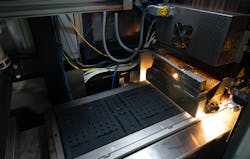Motion Control Brings Injection Molding Quality to Additive Manufacturing
Additive manufacturing (AM), also referred to as 3D printing, moved beyond its initial use in industry solely for prototype development years ago. It’s no longer uncommon for manufacturers to produce assembly-ready components created with AM processes. However, the AM process is not quite ready to replace many established manufacturing methods due to material quality requirements for some parts and unit costs (typically due to the longer production times associated with AM).
To address these AM issues, Evolve (a supplier of AM production equipment) has created its SVP (scalable volume production) platform. The central component of the SVP platform is Evolve’s STEP (selective thermoplastic electrophotographic process) technology, which deposits layers of material and then fuses them into three-dimensional parts with uniform density and quality. According to Evolve, this approach can achieve speeds up to 10 times faster than any industrial 3D printer. It also allows for the creation of multi-material and multi-color parts.
At the heart of Evolve’s SVP platform is an integrated automation package from B&R that includes motion control, process control, safety, HMI (human machine interface), and IIoT (Industrial Internet of Things) connectivity.
Material properties have been among the main obstacles to the use of additive technology for serial production, according to Evolve CEO Steve Chillscyzn. With the B&R motion control system, Chillscyzn says Evolve can precisely synchronize the alignment of the 2D-printed layers between the reciprocating platens and the moving belt. Combined with high-performance pressure and temperature control during the fusing stage, enabled by the B&R automation technologies, the SVP platform can achieve an average surface roughness of only four microns, even without post processing.
The IIoT connectivity provided by B&R system enables the SVP platform to store digital molds in the cloud so that identical parts can be produced anywhere in the world. This means new designs can be implemented without having to produce new physical molds. Chillscyzn says the IIoT connectivity of the system also allows for machine upgrades and maintenance to be implemented remotely to optimize equipment availability and reduce maintenance costs.
About the Author
David Greenfield, editor in chief
Editor in Chief

Leaders relevant to this article:
